

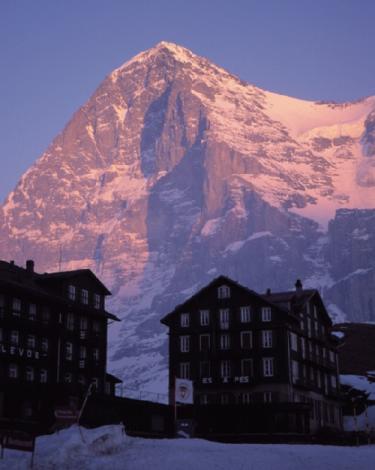 It
was 5.30pm on Saturday, March 8th, 1997. Martin and I were standing on
the train platform at Kleine Scheidegg. Dressed in shoes and jeans, with
climbing gear sprawled out all around us, we looked out of place amongst
the skiers. Above us stood the gigantic 6000 foot North face of the Eiger.
We knew exactly where the 1938 route went, but hadn't decided how to reach
its base. Neither of us have ever seen the face in real life before. We
felt disorientated. We still couldn't believe the events of the previous
few days. We arrived at the bottom of the face by whirlwind..., its name
was Bruce Normand.
It
was 5.30pm on Saturday, March 8th, 1997. Martin and I were standing on
the train platform at Kleine Scheidegg. Dressed in shoes and jeans, with
climbing gear sprawled out all around us, we looked out of place amongst
the skiers. Above us stood the gigantic 6000 foot North face of the Eiger.
We knew exactly where the 1938 route went, but hadn't decided how to reach
its base. Neither of us have ever seen the face in real life before. We
felt disorientated. We still couldn't believe the events of the previous
few days. We arrived at the bottom of the face by whirlwind..., its name
was Bruce Normand.
We had planned a winter attempt on the Eiger as early as the previous October. We ruled out late December and January because we felt that the days were too short and it could be seriously cold. We had no interest in picking a week randomly in February or March, and spending it looking at an out of condition face. We preferred instead to monitor weather closely and go on "standby". This is where the power of the Internet came into being. Using Search Engines I was able to locate 5 day forecasts for Interlaken, Bern and Zurich. I was monitoring skiing conditions in Grindelwald, Swiss avalanche conditions, and was even able to download live images of the Matterhorn as seen through a camera in Zermatt.
But by far the most powerful aid happened via a message I put out on the climbing newsgroup asking Swiss based climbers to keep me up to date regarding mountain conditions. A Scottish climber named Bruce, who is living in Zurich, enthuasiastically and regularly sent me detailed weather/conditions reports. From the middle of that week, there were signs of a strong high pressure building over central Europe. Bruce strongly urged me to go for it. Martin and I made a decision on Thursday evening, paid for flights Friday lunchtime and flew out early on Saturday morning. Bruce met us at the airport, drove us to his house, fed us, gave us epigas cylinders, let us raid his fridge, and drove us to Grindelwald. He would loved to have been on the climb with us, but was recovering from cold injury suffered from a successful ascent of the North face of the Matterhorn the previous month.
Now Bruce was gone and we were on our own in perfect weather, with nothing left to do except climb the face. We spent almost 3 hours on the platform organising equipment and food. The Bahnoff restaurant/bunkhouse was full, so we bivvied outside the station toilets.
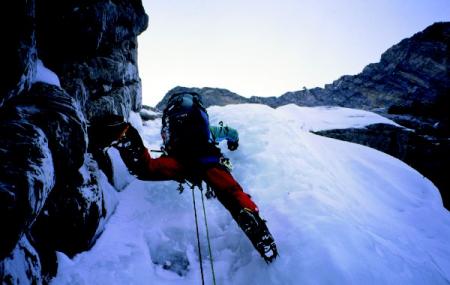 We
woke later than we had wished on Sunday morning, still feeling tired from
the antics of the previous days. After breakfast we walked down the train
tracks to the tunnel and then started diagonally up to the base of the
route. We soon realised our mistake. The snow was soft and in places we
felt like we were swimming. We should have walked up the tracks to the
Eigergletscher station and then traversed down to the base of the route.
We tried as much as possible to keep to small ridge crests where there
was less snow. We were making progress, albeit slowly, and after some hours
we reached the base of the entry chimney. At last the climbing started!
The entry chimney consisted of a 10m pitch of 80 degree ice. Martin led
off up it front pointing indiscriminately and we soon dismissed it. After
this we were moving together on mainly 40 to 50 degree snow slopes. As
we climbed higher we noticed the angle steepening and the difficulties
gradually mounting. We were grateful for the way in which the face was
sucking us in. It was giving us a chance..., a chance to remember.
We
woke later than we had wished on Sunday morning, still feeling tired from
the antics of the previous days. After breakfast we walked down the train
tracks to the tunnel and then started diagonally up to the base of the
route. We soon realised our mistake. The snow was soft and in places we
felt like we were swimming. We should have walked up the tracks to the
Eigergletscher station and then traversed down to the base of the route.
We tried as much as possible to keep to small ridge crests where there
was less snow. We were making progress, albeit slowly, and after some hours
we reached the base of the entry chimney. At last the climbing started!
The entry chimney consisted of a 10m pitch of 80 degree ice. Martin led
off up it front pointing indiscriminately and we soon dismissed it. After
this we were moving together on mainly 40 to 50 degree snow slopes. As
we climbed higher we noticed the angle steepening and the difficulties
gradually mounting. We were grateful for the way in which the face was
sucking us in. It was giving us a chance..., a chance to remember.
Despite several alpine seasons
and greater range expeditions, most of our technical mixed climbing experience
has been gained in Scotland. Martin has been climbing for 20 years and
has regularly made week long winter trips over there. I have been climbing
for almost 10 years. I lived in Aberdeen during the winters of 88/89 to
90/91 where I did quite a lot of winter routes. But since then my technical
winter climbing has consisted of one week in Scotland, a weekend in Wales,
a couple of routes in Ireland and a couple of short routes in the Pyrenees
last December. None of these later routes were particularly demanding and
I was apprehensive about how I would cope on the Eiger. The face was being
kind. It didn't immediately throw anything desperate at us. It was giving
us a chance..., a chance to remember.







As we approached the difficult
crack the climbing intensified. It still wasn't difficult by Eiger standards,
but we noticed that it was runout with some intricate route finding and
delicate moves over snow covered rocky terrain. Progress came to a sudden
halt a pitch below the crack itself. We were confronted by a vertical wall
with 3 old fixed ropes of varying quality hanging down it. I started climbing
the ropes with a prussik attached. It kept locking whenever I put my weight
on it so I took it off (neither of us were familiar with the more sophisticated
knots and prussiks). Climbing the ropes hand over hand was both strenuous
and scary. It involved taking off all gloves and clipping knots in the
ropes for protection. A Canadian climber (see Footnote 1), Conny, who was
working in the Bahnoff had advised us the night before to take jumars.
But to at that stage it was too late. How we wished we had them! I was
climbing the fixed ropes with my ice tools dangling from my wrists. The
pick of my new razor sharp ice hammer cut a finger and blood started dripping
like water from a tap. I was concerned about possibly having to retreat,
belayed, and tried to stop the blood flow as Martin led through. The fixed
ropes led into the difficult crack and Martin continued to its top via
a variation on its right. This turned out to be intricate and technical
with only adequate protection. It was the most trying pitch we had yet
encountered on the route.
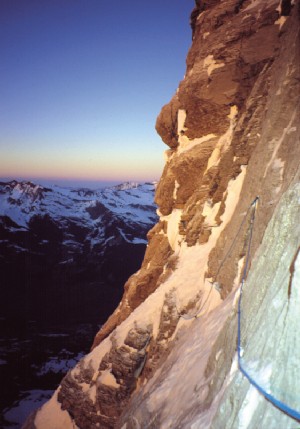
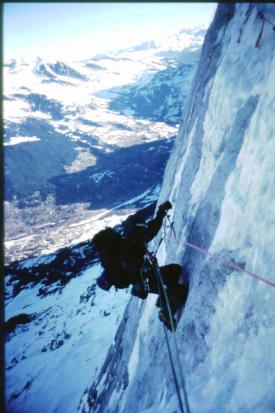
I led on through over easier
ground under the very impressive Rote Fluh. From afar it merely looks like
a small dark patch on the face: one of the Eiger's many features. But when
under it, one cannot help but be impressed by the sheer size of the wall.
This forces a perspective on the vastness of the face. The snowfields under
it led to a more difficult and steep 10m traverse section with an old fixed
rope across it. This was a source of confusion for me. I knew we were near
the Hinterstoisser traverse, yet this was too short for it. I went across
the short traverse pulling on the rope. From its end the rope dropped into
space. It had obviously once been anchored above but had broken away. Up
above there was a choice between an obviously hard but protectable steep
crack with no ice and an equally steep unprotectable offwidth with some
ice in it. In fading light I quickly climbed the offwidth and this led
to the beginning of a brand new rope on the Hinterstoisser. Remembering
Conny's words of advice the previous night, "let yourself walk down a few
metres on to the rope, haul yourself along and you'll be across it in 10
minutes", I started across. It was almost dark and we were aiming for the
Swallows Nest bivvy. Neither of us had seen any obvious bivoauc the entire
day, despite quite a few being mentioned in the route description. We doubted
(and correctly too) if we would even find the Swallow's Nest. Sure, the
bivvys were there, but they were all snow covered. Twenty metres below
the Hinterstoisser was a small comparatively low angled snow field. We
abseiled to it, leaving a rope anchored to the traverse so that we could
top rope ourselves out of there the following morning. The snow patch was
steeper than appeared from above (about 50 degree), but we went to work.
After a couple of hours we had chopped a ledge that we could both lie down
comfortably on. We installed a hand rail to which everything was attached.
Apart from one snow slide where a couple of foot long ice blocks landed
on us, we had a peaceful nights sleep.
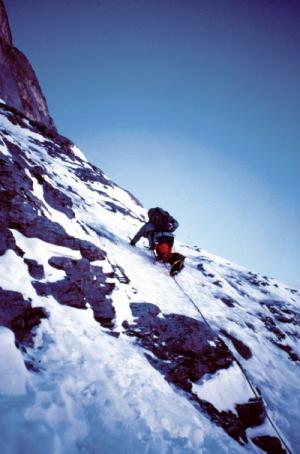
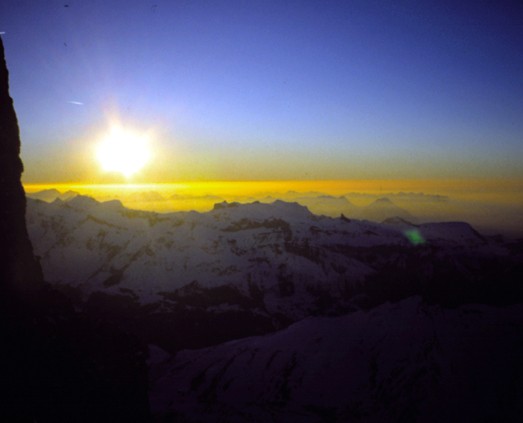
Dawn saw another perfect day
and we started moving around 8am. The second days climbing was similar
in difficulty to the first. The ice hose leading from the first to the
second ice field wasn't fully formed. We strenuously hand over handed a
fixed rope to its left and then traversed on to it higher up. The most
interesting pitch of the day fell to Martin. This was the first pitch leading
from the second icefield up towards the top of the Flatiron. It involved
awkward chimneying, some precision footwork, and like the difficult crack
it would probably have rang in about Scottish Winter Grade V. At one point
Martin's ice axe was lifted out of his harness and dropped. He thought
that was the climb finished but it stuck in the snow lower in the chimney.
He was able to downclimb and retrieve it (see Footnote 2). Death bivvy,
on top of the Flatiron was in a stunning location. There was no need to
dig it out and it was overhung by steep walls. We wouldn't have any ice
blocks paying us a visit that night. We had enough daylight left to get
started on the ramp but couldn't pass such a superb site. The evening sun
came around and I whipped out my sleeping bag to let it dry. The views
were stupendous. There was a sea of low lying clouds in the distance with
jagged peaks protruding through it. We felt warm in the evening sun, and
those minutes before the sun set were some of the most peaceful I'd ever
experienced on a mountain. This was some bonus! The human animal was happy!!
Nobody had ever told us about winter sun on the North face of the Eiger.













The following day we traversed
to the bottom of the ramp and I led up the first pitch. The climbing was
both interesting and enjoyable. I ran out a full rope length with no sign
of a decent belay, so we moved together for some metres until I arrived
at a good stance. Martin led through on another intricate pitch. We could
both now sense that the route was "gearing up". It wasn't going to give
us easy passage. It had history..., tragic history, passionate history,
wonderful history, and we were going to get a glimpse of it. The third
pitch on the ramp was one of the most completely absorbing pitches I've
ever led. The terrain wasn't strenuous, but was of a superbly tenuous nature.
The crampons had to balance on small ledges. The ice tools were sometimes
called upon to play, but more often dangling. The hands were locating side
pulls, palming off sloping holds. This style of climbing continued for
approximately 10 metres from a good runner to the belay with no chance
of gear in between. The mind was at one with the problems presented. The
only thoughts were for the pitch. The runout didn't matter. The moves were
being executed under control. Complete focus on a superb route. Complete
absorption with a route that we had wanted for years..., a route that we
wanted like nothing else. YES!!, this is climbing at its very best. This
is mountaineering in its most artistic form. We were grateful that the
route waited until the third day before throwing this at us. It gave us
a chance..., and we remembered.







Martin led through to the
foot of the icy chimney. I couldn't believe my eyes when I saw it. It was
steep, then overhanging and very awkward looking. Beforehand, we listened
when people said that the Eiger wasn't difficult by modern standards. Sure
it isn't, but to our ears this meant no more than Scottish winter grade
V. The further we climbed up the ramp, the more convinced we became that
if in isolation in Scotland, it would be registering a solid (VI,6) on
the Richter scale. I wanted the icy chimney to just go away but knew it
wouldn't. I didn't particularly want to lead it but knew we couldn't start
shirking leads. We hadn't up until then. We had always led through and
I couldn't upset the psychological balance now. In the lower section there
was some fixed pitons with old tat hanging from them. I was generally able
to hook the tat from a rest point on the lower runner. All insitu gear
disappeared towards the top, requiring the final metres to be free climbed.
Summoning reserves of energy, I didn't bother trying to place protection
and made the required moves.
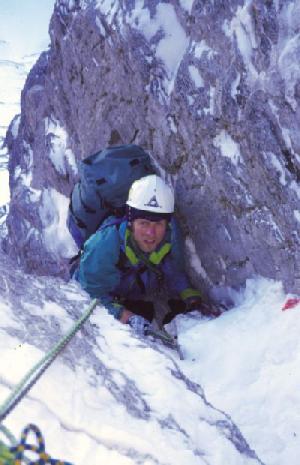
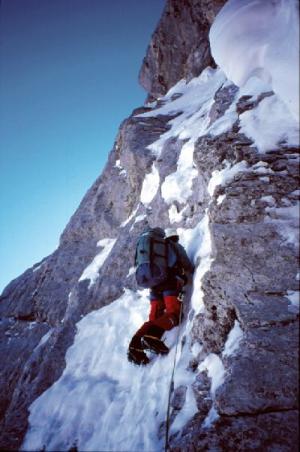
The next pitch was even more
difficult. Martin led over steep ground on thin ice to the base of a short
overhanging headwall left of the ice bulge. He had runout enough rope to
justify a belay but chose instead to continue. He climbed up the headwall,
clipping some fixed gear and placing more of his own. He tried to make
the moves right towards the top of the ice bulge and lobbed off. Or rather,
he knew he was about to come off, so he cooly jumped to avoid unwanted
encounters with sharp edges. He immediately tried once more. As he started
moving right towards the ice, I didn't feed out the rope quick enough.
Off he came again. He traversed right to the overhanging ice bulge. One
blow of the axe and it came down on top of him. It wasn't properly formed
so he went back to the headwall. I offered to give it a go. His head turned
around and I saw the glint of determination in his eyes. This lead was
going to be his. He went at it for the third time. This time he spotted
a friend placement at hip level out to his right. He swung onto the friend
and made the necessary moves to reach the ice.
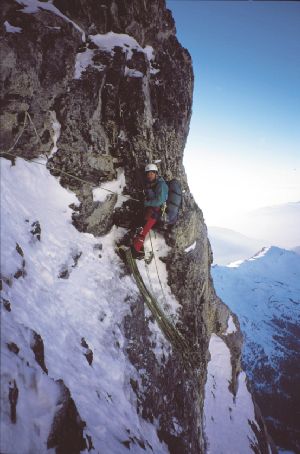










The ramp was finished. It
was time consuming but we were now entering the upper reaches of the face.
The brittle ledges were named appropriately. They weren't particularly
difficult but required a lot of care. Martin traversed beyond the brittle
ledges and belayed at the bottom of the vertical 18m pitch which is used
to access the Traverse of the Gods. In the route description this is described
as the key to the upper face. As with the icy chimney, my eyes almost popped
from my head when I saw it. This was a vertical wall, but unlike similar
walls lower on the face there were no fixed ropes hanging down it. I removed
my gloves in preparation for the impending challenge. I instinctively knew
that the pitch would demand more of me than any single mixed pitch ever
had before. I started bridging up the vague groove above me. It felt awkward
as my front points were clawing on small holds trying to gain purchase.
As I came to fixed equipment I gratefully rested on it. Lower down there
were some small cracks which gladly accepted my ice tools. Higher up these
seemed to disappear. So did the pitons. The holds, although big, were smooth
and generally sloping down at an angle of about 10 degrees. Unlike in Scotland,
there was very little to hook the picks on. The flat holds were wet from
snow cover and so smooth that bare hands just slid off them. This frustated
me because I knew there would be no problem pulling on such holds on similar
dry rock back home. The best bet for progress seemed to be side pulls.
About half way up my feet were a metre or so above my last pieces of protection.
My calve muscles were aching. I felt extremely uncomfortable. My legs started
shaking. Years ago in Aberdeen I was often slagged while rock climbing
over the "Harrington leg shake". This diminished over the years but I had
never before shook uncontrollably in crampons. I was looking at a small
fall. I'd never fallen on a winter route before and didn't want to start
now. The likelihood is that a fall would have been okay. But the Eiger
is not renowned for its rock quality and I had no desire to test it. Still
shaking, I spotted a friend placement, lashed in a number three, and promptly
rested on it. I moved on up a little to more insitu equipment and considered
belaying. But I knew this would be copping out. This 18 metres of climbing
is there to be done as one pitch. I had no desire to shirk a lead at this
stage. I pushed on and arrived at the belay, relieved and tired.
The route description talked
about a good bivouac near the beginning of the Traverse of the Gods. Martin
passed it initially in search of our idealistic perch. He scouted around
but saw nothing except steep unfriendly ground. He came back towards me
and spotted a short hand rail. He started clearing snow and it soon became
apparent that this was the intended site. I joined him and we soon had
a comfortable platform cut on which we could both lie down. It was overhung
by a short wall and was completely safe, though not as spectacular as Death
Bivvy. We were tired that evening. Our backs were stiff and our muscles
ached. I seemed to be fumbling when holding things. I dropped a camera
film and was disgusted with my clumsiness. I thought it was gone but later
found that it had stopped on the ledge. I dropped a bag but there was nothing
important in it. It became apparent that we needed to get sleep. Cooking
was a necessary chore, as we ate very little all day. Sleep had to wait
for another couple of hours. My darkest moments on the climb probably occured
that night. All the stories we had heard below were of the Exit cracks.
Nobody talked about how hard the ramp was. We just had the most difficult
days climbing of our lives. We had to dig deep into ourselves to get to
where we were. We were wondering how much more difficult the Exit cracks
would be. We were wondering how much harder we could actually climb. On
the positive side the weather was still perfect and we could stretch our
food and fuel for another 3 days if need be. We didn't have to remove our
rucksacks yet and this was something we could always resort to. We knew
we should be able to climb out of the face the following day, but doubts
were there.
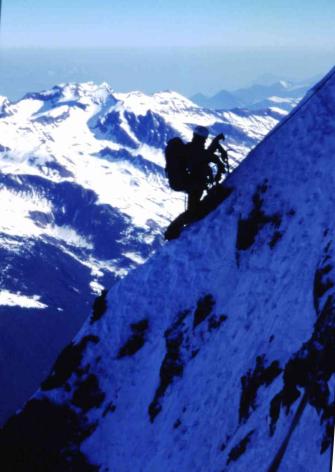





The Traverse of the Gods
was crossed smoothly and efficiently. The final pitch leading to the Spider
was runout. There was only one set of runners near the belay in a pitch
that was somewhere between 20 and 30 metres long. It wasn't particularly
steep but everything revolved around balancing crampon points on snow covered
ledges. There were no positive handholds. Only rock that could be pushed
down upon to take some weight of the feet. It was a psychological passage.
No leader, no second. The same for both. Earlier on in the climb it could
have presented a problem for us. But at this stage of the game, our senses
were dulled to the reality of runout. The spirits were dancing as we tiptoed
our way across.
We reached the Spider and saw the Exit cracks up close for the first time. We had a good nights sleep and felt relaxed. Positive feeling consumed me. The voice from within told me that we would climb them. It told me that we would climb them well! We ascended the Spider keeping to its right edge so as to keep some protection on the rope between us. I led up the first pitch of the Exit cracks. It was almost a full rope length with about a 20m section of solid 80 degree ice. It presented no problems. Martin led through on lower angled ground to a good belay. Now was decision time. We could see the line taken by the first ascent. It looked desperate and invoked images of crampons scrabbling on steep smooth rock. Conny told us that in February, two Austrians spent hours trying to climb it without success. They abseiled off it and traverse left to another gully system. The same month there was also a party of 6 Germans on the route. The party included the 3 Huber brothers. They didn't fancy the original line either, and made a "very difficult unprotected 10m rock traverse to an ice gully which led all the way to the top". We could see the ice gully. It looked continuous. We liked it. We could see the rock traverse. It looked desperate. We hated it. It was completely on rock, and bulged out sufficiently to push the body off balance. We were sufficiently well acquainted with the face at that stage to know that the traverse wouldn't offer positive holds. Alex Huber made the first free ascent of Yosemite's Salathe wall. He is a good rock climber, as good as anybody in the world. A class apart from us. Rocky traverse..., no thanks.
In between the original line and this gully was yet another gully. It started just above us. Higher up we could see a fixed rope linking this middle gully to the one which the Hubers had followed. There was also a pure rock traverse to gain it. But in the rock was a sole piton with a metre long piece of tat attached to it. Experience instantly told us that this was used in a tension traverse. I moved up towards it, placing a backup piton a few metres to its right. By inserting my ice axe pick in the tat and laying off it at full stretch, I was able to reach over and plant my ice hammer solidly in the bed of the gully. Bingo!! One solid placement was all that was needed. My weight was immediately transferred onto it and I continued up the gully until rope drag forced me to belay. Martin led through over awkward ground to reach the fixed rope. He descended diagonally leftwards on it to reach the gully which the Germans had accessed lower down.
The next pitch didn't look
too bad. It was a narrow 70 degree ice filled groove. I started working
my way methodically up it, planting my ice hammer towards its left side
and my ice axe towards its right. The ice was generally good but never
thicker than a few centimetres. The rock on either side of the ice runnel
was compact and featureless. There wasn't a single piece of in-situ gear
to be found. It soon became apparent that the groove would have to be climbed
without protection. I wasn't particularly worried as I was making steady
progress. As on the third pitch of the ramp, I became completely focused
on the moves in hand. Nothing else in the world mattered. About 15 metres
up from the belay the ice disappeared in the right hand side of the groove.
With my axe I struck the ice on the left about a foot or so above my hammer.
Above this the ice was too thin on the left but better on the right. With
my hammer in my left arm, I had to swing diagonally across my right to
get a placement. I swung and the ice shattered. As this stage of the climb
the pick was blunted and with the awkward angle I couldn't grasp the shaft
as firmly as normal. I aimed again a little higher and saw the ice fall
away. There was no good ice left within arms reach. The walls on either
side of the groove were bare. Featureless. I envisaged desperate moves.
Above protection, as on the ramp or access to the Gods, this is reasonable.
Fifteen metres out from the belay, with nothing in between, its not. I
looked down and saw little hope of successfully reversing the moves. Besides,
there was no point. There was no other way out. I knew I couldn't risk
moving up with only a couple of the pick teeth biting in poor ice. I placed
my ice hammer firmly, a few centimetres below my axe. I mantleshelfed up
on both tools, keeping the body as close to the ice as possible. I removed
the axe and reached high above the hammer. The body was alive! My arteries
and veins felt like the walls of a gorge trying to restrain a raging torrent.
Adrenalin was surging through me. I picked my spot, held the axe firmly
and struck carefully. I heard a deep thud. The placement was solid. I was
back on course. The spirit was on fire. It burned strongly. It burned brightly.
It danced beautifully. It danced like never before. We had almost cracked
the route. The Exit doors were opening. There was only one more hard pitch.
It wasn't as steep as the previous one. But it was more delicate. There
was less ice and more rock. Martin found this equally absorbing, equally
consuming. As he approached the belay the ground lit up. The rays of the
sun strike the face earlier in its upper reaches.
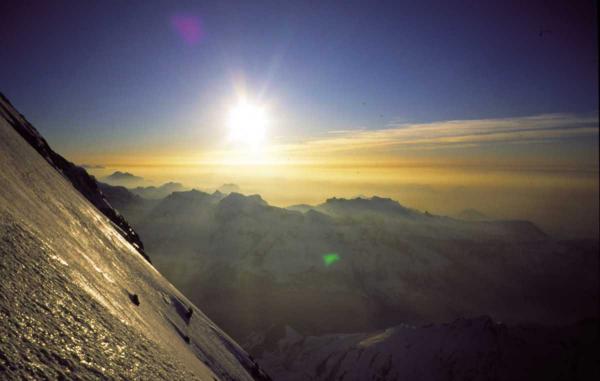
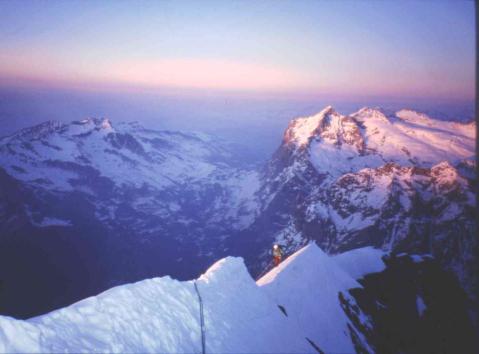
A few more ropelengths over
easier ground brought us to the summit ice slopes. They glistened brighlty
in the setting sun. The summit ridge was narrow and offered fine views.
It was windy on top and getting dark. We found a sheltered spot on the
South side of the summit ridge where we could hack a good ledge. We were
tired and decided that it would be far safer to bivvy and descend in the
morning. We shook hands but felt no excitment. Years of mountaineering
told us that the route isn't finished until one is safely down.
We waited until sunrise before preparing breakfast. It had been a cold night. Care was needed on the traverse of the summit. The ridge was knife edged and the wind blew strong. Clouds of snow were being propelled vertically above it. It was too uncomfortable to stop for a summit photo. Conny had told us that there was an easier way of descending the west flank in winter: "As soon as you are level with the seracs, head left to the top of a snow gully. It brings you all the way to the bottom". He meant the seracs on the west flank. We interpreted it as meaning the obvious higher seracs that we could see on the eigergletcher. We traversed left towards the top of a snow gully. It was safe initially but then came out underneath the lower seracs. We saw the avalanche debris and felt threatened. We reckoned that we would be unfortunate to be caught in one, but hurried nonetheless. The mountain was keeping us in suspense right up until the very last. The final few hundred metres of snow to the Eigergletcher station was soft. We sometimes sank to our waists. We cursed it. Only when we were safe on the station platform did the full euphoria of what we had done begin to sink in. We left our gear unattended on the platform (we took our film and camera in with us - they were our only material possessions of any importance) and went into the restaurant for a huge feed. An elderly woman came up to us and gave us money for a few beers. Through a telescope, she saw us traverse the summit earlier on that day. I was embarrassed as a few tears sneaked out through the corners of my eyes. Not tears of sadness. Tears of joy..., tears of joy for a wonderfully exhilarating experience on the greatest Alpine route of them all.
Climbers: Martin Daly and Paul Harrington.Both born and living in Dublin, Ireland.
Weather: Apart from it being quite windy on the summit, the weather was perfect for the 5 days we were on the mountain. The daytime climbing temperature was similar to that which one would experience in Scotland in crisp conditions. There was never the least sign of thaw anywhere on the face, but the temperatures were still a lot milder than we had expected. We had no thermometer but I would guess that the daytime temperatures were between -3 and -8 degrees centigrade. The night time temperatures on the face were probably around -10 with it possibly being as cold as -15 on the summit. Apart from the few ice blocks on our first bivvy and a couple of stones seen by Martin, there was no fallout. The face was quiet.
Conditions: Conny who was on the face in February said that there was a much greater build up of ice then. It was also a lot colder so it was much more difficult to climb with just inner gloves. One of the Swiss climbers on the route around the same time as ourselves was Norbert Joos who has climbed 10 of the 14 8000ers. His ascent this time was a guided ascent, and he had been on the route before. He told Conny that it was in poor condition. We're not so sure that conditions were bad. There may have been less ice than normal, but there was no fresh powder lying around and I reckon that perfect weather more than compensates for slightly rougher climbing conditions.
Accomodation: The Bahnoff restaurant/bunkhouse
at Kleine Scheidegg comes highly recommended. We spent 3 nights there chilling
out after the route. The cost was 55 Swiss Francs a night (roughly 25 pounds)
for full board. This included an eat as much as you want breakfast and
a excellent 4 course evening meal with large helpings. We found the staff
very friendly and were looked after very well.
The entry chimney: (IV,4)
From the triangular snow slope up to the fixed ropes below the difficult crack: (V,4)
Fixed ropes below the difficult crack, on the Hinterstoisser traverse and between the first and second ice fields: Ungradeable, but if the ropes were not there you can be sure that in typical winter conditions you would be talking about no less than Scottish winter Grade VI.
Difficult crack: (V,5)
The first pitch off the end of the second ice field: (V,5)
The Ramp from the bottom up to the snow slope before the Brittle ledges: (VI,6) and A1
Brittle ledges: (IV,3)
The 18m vertical access pitch to the traverse of the Gods: (V,6) and A1
Traverse of the Gods: (V,4)
Exit cracks: (VI,5) and A1. This is assuming the easiest route is taken and it is possible to tension traverse into the middle gully. If one of the other variations had to be climbed you're probably talking about (VI,6) or maybe even (VI,7).